Abstract
Animal joints are valuable proxies for those of humans in biomechanical studies, however commonly used quadruped knees differ greatly from human knees in scale and morphometry. To test the suitability of the cervine stifle joint (deer knee) as a laboratory model, gross morphometry, ACL cross section, and ACL rupture strength were measured and compared to values previously reported for the knees of humans and commonly studied animals. Twelve knee joints from wild white-tailed deer were tested. Several morphometry parameters, including bicondylar width (53.5 ± 3.0 mm) and notch width (14.7 ± 2.5 mm), showed a high degree of similarity to those of the human knee, while both medial (16.7 ± 2.1°) and lateral (17.6 ± 4.7°) tibial slopes were steeper than in humans but less steep than other quadrupeds. The median ACL rupture force (2054 N, 95% CI 2017–2256 N), mean stiffness (260 ± 166 N/mm), mean length (33 ± 7 mm), and mean cross sectional area (44.8 ± 18.3 mm2) were also comparable to previously reported values for human knees. In our limited sample size, no significant sexual dimorphism in strength or morphometry was observed (p ≥ 0.05 for all parameters), though female specimens generally had steeper tibial slopes (lateral: p = 0.52, medial: p = 0.07). Our results suggest that the deer knee may be a suitable model for ex vivo studies of ACL rupture and repair.






Similar content being viewed by others
References
Baer, G. S., and C. D. Harner. Clinical outcomes of allograft versus autograft in anterior cruciate ligament reconstruction. Clin. Sports Med. 26:661–681, 2007.
Brophy, R. H., B. L. Gray, R. M. Nunley, R. L. Barrack, and J. C. Clohisy. Total knee arthroplasty after previous knee surgery: expected interval and the effect on patient age. J. Bone Joint Surg. Am. 96:801–805, 2014.
Calvert, N., N. Grainger, and M. Hurworth. Use of bovine carpal joints as a training model for cruciate ligament repair. Anz J. Surg. 83:933–936, 2013.
Celarek, A., S. F. Fischerauer, A. M. Weinberg, and E. K. Tschegg. Fracture patterns of the growth plate and surrounding bone in the ovine knee joint at different ages. J. Mech. Behav. Biomed. Mater. 29:286–294, 2014.
Chandrashekar, N., H. Mansouri, J. Slauterbeck, and J. Hashemi. Sex-based differences in the tensile properties of the human anterior cruciate ligament. J. Biomech. 39:2943–2950, 2006.
Corbiere, N. C., K. A. Lewicki, K. A. Issen, and L. Kuxhaus. Creating physiologically realistic vertebral fractures in a cervine model. J. Biomech. Eng. 136:064504, 2014.
Dargel, J., J. W. Michael, J. Feiser, R. Ivo, and J. Koebke. Human knee joint anatomy revisited: morphometry in the light of sex-specific total knee arthroplasty. J. Arthroplast. 26:346–353, 2011.
Eguchi, A., M. Ochi, N. Adachi, M. Deie, A. Nakamae, and M. A. Usman. Mechanical properties of suspensory fixation devices for anterior cruciate ligament reconstruction: comparison of the fixed-length loop device versus the adjustable-length loop device. Knee 21:743–748, 2014.
Filho, E. S., M. H. Mendes, S. Claudino, F. Baracho, P. C. Borges, and L. A. da Cunha. Biomechanical analysis on transverse tibial fixation in anterior cruciate ligament reconstructions. Rev. Bras. Ortop. 50:174–179, 2015.
Fleming, B. C., J. L. Carey, K. P. Spindler, and M. M. Murray. Can suture repair of ACL transection restore normal anteroposterior laxity of the knee? An Ex vivo study. J. Orthop. Res. 26:1500–1505, 2008.
Halewood, C., M. T. Hirschmann, S. Newman, J. Hleihil, G. Chaimski, and A. A. Amis. The fixation strength of a novel ACL soft-tissue graft fixation device compared with conventional interference screws: a biomechanical study in vitro. Knee Surg. Sports Traumatol. Arthrosc. 19:559–567, 2011.
Hashemi, J., N. Chandrashekar, H. Mansouri, B. Gill, J. R. Slauterbeck, R. C. Schutt, Jr, E. Dabezies, and B. D. Beynnon. Shallow medial tibial plateau and steep medial and lateral tibial slopes: new risk factors for anterior cruciate ligament injuries. Am. J. Sports Med. 38:54–62, 2010.
Hedgeland, M., M. Libruk, N. Corbiere, M. Ciani, and L. Kuxhaus. The Odocoileus virginianus femur: mechanical behavior and morphology. PLoS ONE 11:e0146611, 2016.
Isaac, D. I., E. G. Meyer, and R. C. Haut. Development of a traumatic anterior cruciate ligament and meniscal rupture model with a pilot in vivo study. J. Biomech. Eng. 132:064501, 2010.
Kaplan, E. L., and P. Meier. Nonparametric estimation from incomplete observations. J. Am. Stat. Assoc. 53:457–481, 1958.
Kiapour, A. M., M. R. Shalvoy, M. M. Murray, and B. C. Fleming. Validation of porcine knee as a sex-specific model to study human anterior cruciate ligament disorders. Clin. Orthop. Relat. Res. 473:639–650, 2015.
Kieser, D. C., S. Kanade, N. J. Waddell, J. A. Kieser, J. C. Theis, and M. V. Swain. The deer femur–a morphological and biomechanical animal model of the human femur. Biomed. Mater. Eng. 24:1693–1703, 2014.
Kumar, N., S. Kukreti, M. Ishaque, D. K. Sengupta, and R. C. Mulholland. Functional anatomy of the deer spine: an appropriate biomechanical model for the human spine? Anat. Rec. 266:108–117, 2002.
Li, G., S. E. Park, L. E. DeFrate, M. E. Schutzer, L. Ji, T. J. Gill, and H. E. Rubash. The cartilage thickness distribution in the tibiofemoral joint and its correlation with cartilage-to-cartilage contact. Clin. Biomech. (Bristol, Avon) 20:736–744, 2005.
Lingle, S. Escape gaits of white-tailed deer, mule deer, and their hybrids—body configuration, biomechanics, and function. Can. J. Zool. 71:708–724, 1993.
Martin, R. K., D. Gillis, J. Leiter, J. S. Shantz, and P. MacDonald. A Porcine Knee model is valid for use in the evaluation of arthroscopic skills: a pilot study. Clin. Orthop. Relat. Res. 474:965, 2015.
Martinez-Carranza, N., L. Ryd, K. Hultenby, H. Hedlund, H. Nurmi-Sandh, A. S. Lagerstedt, P. Schupbach, and H. E. Berg. Treatment of full thickness focal cartilage lesions with a metallic resurfacing implant in a sheep animal model, 1 year evaluation. Osteoarthr. Cartil. 24:484, 2015.
Osterhoff, G., S. Loffler, H. Steinke, C. Feja, C. Josten, and P. Hepp. Comparative anatomical measurements of osseous structures in the ovine and human knee. Knee 18:98–103, 2011.
Pink, M., J. Perry, P. A. Houglum, and D. J. Devine. Lower extremity range of motion in the recreational sport runner. Am. J. Sports Med. 22:541–549, 1994.
Proffen, B. L., M. McElfresh, B. C. Fleming, and M. M. Murray. A comparative anatomical study of the human knee and six animal species. Knee 19:493–499, 2012.
Race, A., and A. A. Amis. Cross-sectional area measurement of soft tissue. A new casting method. J Biomech 29:1207–1212, 1996.
Rowe, P. J., C. M. Myles, C. Walker, and R. Nutton. Knee joint kinematics in gait and other functional activities measured using flexible electrogoniometry: how much knee motion is sufficient for normal daily life? Gait Posture 12:143–155, 2000.
Salter, R. B., and W. R. Harris. Injuries involving the epiphyseal plate. J. Bone Joint Surg. 45:587–622, 1963.
Saunders, D. A. Adirondack Mammals. State University of New York, College of Environmental Science and Forrestry, 1988.
Smith, H. C., P. Vacek, R. J. Johnson, J. R. Slauterbeck, J. Hashemi, S. Shultz, and B. D. Beynnon. Risk factors for anterior cruciate ligament injury: a review of the literature—part 1: neuromuscular and anatomic risk. Sports Health 4:69–78, 2012.
Strickland, S. M., T. W. Belknap, S. A. Turner, T. M. Wright, and J. A. Hannafin. Lack of hormonal influences on mechanical properties of sheep knee ligaments. Am. J. Sports Med. 31:210–215, 2003.
Su, S. C., J. G. Skedros, K. N. Bachus, and R. D. Bloebaum. Loading conditions and cortical bone construction of an artiodactyl calcaneus. J. Exp. Biol. 202:3239–3254, 1999.
Tapper, J. E., S. Fukushima, H. Azuma, G. M. Thornton, J. L. Ronsky, N. G. Shrive, and C. B. Frank. Dynamic in vivo kinematics of the intact ovine stifle joint. J. Orthop. Res. 24:782–792, 2006.
Throop, A. D., A. K. Landauer, A. M. Clark, and L. Kuxhaus. Cervine tibia morphology and mechanical strength: a suitable tibia model? J. Biomech. Eng. 137:034503, 2015.
Williams, 3rd, R. J., T. L. Wickiewicz, and R. F. Warren. Management of unicompartmental arthritis in the anterior cruciate ligament-deficient knee. Am. J. Sports Med. 28:749–760, 2000.
Yang, S. Y., H. Yu, W. Gong, B. Wu, L. Mayton, R. Costello, and P. H. Wooley. Murine model of prosthesis failure for the long-term study of aseptic loosening. J. Orthop. Res. 25:603–611, 2007.
Acknowledgments
Funding for this work was provided by the Department of Mechanical & Aeronautical Engineering at Clarkson University. The authors have no conflicts of interest to declare.
Author information
Authors and Affiliations
Corresponding author
Additional information
Associate Editor Sean S. Kohles oversaw the review of this article.
Rights and permissions
About this article
Cite this article
Zaino, N.L., Hedgeland, M.J., Ciani, M.J. et al. White-Tailed Deer as an Ex Vivo Knee Model: Joint Morphometry and ACL Rupture Strength. Ann Biomed Eng 45, 1093–1100 (2017). https://doi.org/10.1007/s10439-016-1746-8
Received:
Accepted:
Published:
Issue Date:
DOI: https://doi.org/10.1007/s10439-016-1746-8




